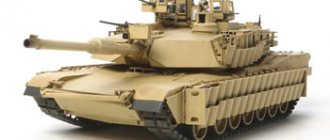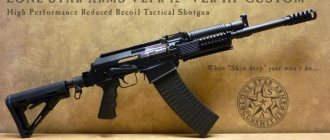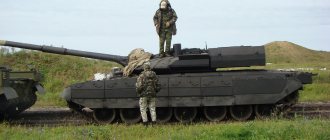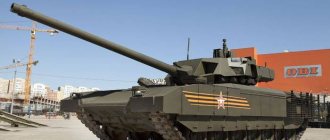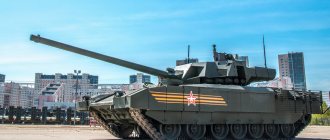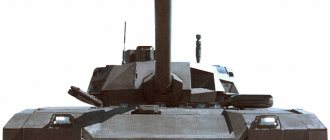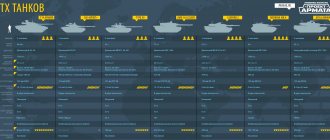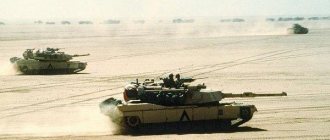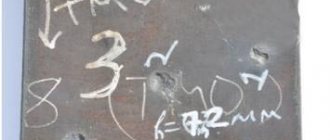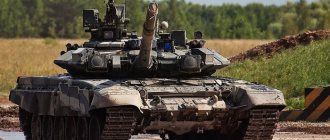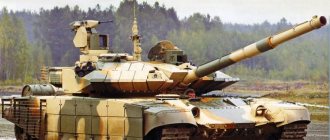Such criteria were presented for the use of the tank in cramped and mountainous areas of Japan. The main feature of the Japanese tank is the use of modular composite armor. Armament is a 120 mm smoothbore gun developed by Japan Steel Works with an automatic loader and 7.62 mm and 12.7 mm machine guns. It is believed that the weight of the Type 10 main battle tank with all armor sets will be about 50 tons.
| 3 | |
| Specific power, hp/t | 27,3 |
| Length with gun forward, mm | 9420 |
| Width, mm | 3240 |
| Height, mm | 2300 |
| Gun type | SHG |
| Gun caliber, mm | 120 |
| Machine guns, number x mm | 1 x 7.62, 1 x 12.7 |
| Armor | modular ceramic composite |
| engine's type | diesel |
| Engine power, l. With. | 1200 |
Photos of a modern Japanese tank:
| Click on the tank photo to enlarge |
In terms of dimensions, the Type 10 is closer to the Japanese Type 74 tank. The main complaint of the Japanese military about the Type 90 tank was precisely its high cost - 7.4 million dollars, 3 million more than the price of the American Abrams, as well as the mass dimensional characteristics that prevent the free transportation of tanks by rail and independent movement on roads within the country. So when creating the Type 10, Mitsubishi Heavy Industries Ltd. fulfilled the wishes of the military and developed a cheaper and more compact version of the MBT. The cost of the Japanese Type 10 tank is estimated at 6.5 million US dollars.
Comparative performance characteristics of some modern tanks
Merkava
| Merkava Mk.4 | |
| Year of adoption | 2004 |
| Combat weight, t | 65,0 |
| Crew | 4 |
| Gun caliber, mm | 120 |
| Guided weapons | LAHAT |
| Ammunition, shots | 48 |
| Rate of fire, rds/min | n/a |
| Dynamic protection | Yes |
| Active protection | Trophy |
| Engine power, l. With. | 1500 |
| Specific power, l. s./t | 23,1 |
| Maximum speed, km/h | 70 |
| Cruising range on the highway, km | 450 |
Japanese Type 10. Tank with no chance of attack
Japan's Self-Defense Forces are severely limited by the post-war constitution that the United States imposed on a capitulated Japan. According to this document, Japan renounces war as an instrument of international interaction and does not have an army at all. True, Japan's self-defense forces look quite powerful, but there is a clear bias towards defense.
The current Japanese government considers the current situation offensive and the constitution overly pacifistic. And after the recent elections, the ruling coalition managed to obtain a parliamentary majority, which allows us to expect a change in the Japanese constitution in the near future. True, it is unlikely that immediately after the constitutional change, the Japanese Self-Defense Forces will rename themselves into the army and immediately go to war with China. But the opportunity will open up for the export of military equipment.
Photo: pro-tank.ru
The Japanese consider their newest main battle tank Type 10 to be one of the main candidates for sale abroad, but this vehicle, although quite modern, has a number of distinctive features that make the prospects for exporting this vehicle very vague.
Japanese electronics
The strength of this tank is its electronic content. The C4I (command, control, communications, computers, and (military) intelligence) system allows Type 10 tanks to exchange information with each other automatically within the unit. This will undoubtedly enhance the combat capabilities of Japanese armored units. A fire control system and an automatic system for ejecting smoke grenades when the tank is irradiated with laser beams would not be a problem. These electronic tanker assistants are useful for any modern tank, and having them on the Type 10 is a must. However, such systems are no longer new.
But other strengths of the Japanese tank may well become obstacles to export.
Problems with excess weight
The Type 10 was originally designed as a lighter tank compared to its predecessor. The base weight of the vehicle does not exceed 44 tons, and if you remove the modular metal-ceramic armor, it will be reduced by another 4 tons. The low weight is due to the geographical features of Japan. Many islands of volcanic origin are replete with ravines, gorges and failures, over which bridges of very moderate load-bearing capacity are thrown.
Photo: russian.china.org.cn
Even a lightweight Japanese tank can move only 85% of the largest bridges in Japan, while the MBTs of the leading tank powers approach 50 tons in weight, and some, like the Israeli Merkava or the American Abrams, weigh more than 60 tons. Thus, the Type 10 is ideally suited for moving around Japan, but when participating in international tenders it turns out that armor had to be sacrificed for the sake of less weight.
Armor, suspension and gun
The Type 10 is positioned by the Japanese military as an ideal tank for fighting irregular forces. Particular attention is paid to protection against RPG-7 and its countless modifications. For this reason, the tank is equipped with powerful side armor, which can be expanded with additional modules. However, the American experience of the war in the Middle East shows that mines are a popular means of countering tanks among militants, but the Japanese, accustomed to operating on their home islands, are not doing well with mine protection.
Another dubious advantage is the hydropneumatic suspension. In the difficult terrain of Japan, it turns out to be simply irreplaceable, but in the conditions of a relatively flat theater of operations, it becomes more of an additional complex mechanism that can also break down.
Photo: weapons-system.blogspot.ru
As for the gun, the Japanese designers did not fantasize and equipped the tank with a licensed copy of the German Rheinmetall Rh-120 tank gun with a 44-caliber barrel. The standard NATO caliber allows the use of shells already in stock, which is a definite advantage. But it’s worth remembering that Western designers are already working hard to create 130 and 140 mm. guns that will be installed on promising US and German tanks. Thus, there is no advantage in firepower for the Type 10.
Finally
The Japanese Type 10 is certainly a worthy representative of the tank family, but it is only focused on combat operations on its native islands. This is not surprising for a country that has not thought about armed expansion for the last half century. But the prospects for export supplies are limited by the same specificity of the tank.
As for Japan’s ability to export its armored units from the country for use in large-scale combat operations abroad, it is worth mentioning the meager landing capabilities of the Japanese fleet. Japan is not able to transport any significant number of tanks to the mainland.
Thus, the Type 10 will in the near future remain exclusively a means of defending Japan against armed invasion. Well, since there are no people willing to invade Japanese territory with weapons, the Type 10 actually becomes a tank with no chance of attack. Not so much a real combat vehicle, but a demonstrator of the capabilities of Japanese industry.
Arjun
| Arjun Mk.I | |
| Year of adoption | 2011 |
| Combat weight, t | 58,5 |
| Crew | 4 |
| Gun caliber, mm | 120 |
| Guided weapons | LAHAT |
| Ammunition, shots | 39 |
| Rate of fire, rds/min | 6-8 |
| Dynamic protection | n/a |
| Active protection | n/a |
| Engine power, l. With. | 1400 |
| Specific power, l. s./t | 23,9 |
| Maximum speed, km/h | 70 |
| Cruising range on the highway, km | 450 |
Al-Khalid
| Al-Khalid | |
| Year of adoption | 2001 |
| Combat weight, t | 48,0 |
| Crew | 3 |
| Gun caliber, mm | 125 |
| Guided weapons | No |
| Ammunition, shots | 49 |
| Rate of fire, rds/min | 8 |
| Dynamic protection | Yes |
| Active protection | Varta |
| Engine power, l. With. | 1200 |
| Specific power, l. s./t | 25,0 |
| Maximum speed, km/h | 70 |
| Cruising range on the highway, km | 500 |
Zulfiqar
| Zulfiqar-3 | |
| Year of adoption | n/a |
| Combat weight, t | 36,0 |
| Crew | 3 |
| Gun caliber, mm | 125 |
| Guided weapons | No |
| Ammunition, shots | n/a |
| Rate of fire, rds/min | n/a |
| Dynamic protection | n/a |
| Active protection | n/a |
| Engine power, l. With. | 780 |
| Specific power, l. s./t | 21,7 |
| Maximum speed, km/h | 70 |
| Cruising range on the highway, km | 450 |
Tiger of Storms
| Tiger of Storms | |
| Year of adoption | 2002 |
| Combat weight, t | n/a |
| Crew | n/a |
| Gun caliber, mm | 125 |
| Guided weapons | No |
| Ammunition, shots | n/a |
| Rate of fire, rds/min | n/a |
| Dynamic protection | n/a |
| Active protection | n/a |
| Engine power, l. With. | n/a |
| Specific power, l. s./t | n/a |
| Maximum speed, km/h | n/a |
| Cruising range on the highway, km | n/a |
K1A1
| K1A1 | |
| Year of adoption | 2001 |
| Combat weight, t | 53,2 |
| Crew | 4 |
| Gun caliber, mm | 120 |
| Guided weapons | No |
| Ammunition, shots | n/a |
| Rate of fire, rds/min | n/a |
| Dynamic protection | n/a |
| Active protection | No |
| Engine power, l. With. | 1200 |
| Specific power, l. s./t | 22,5 |
| Maximum speed, km/h | 65 |
| Cruising range on the highway, km | 500 |
, VRN YANNRBERYARBNBUKN 1922 TsNDS. mNBYU LYUHMY OPEDYARYUBKKYU YANANI DBSULEYARMSHI ZHEKEMNDEPEBMMSHI AHOKYUM, NYAMYUYEMMSHI DBSL ONOKYUBYULH. dK NAEYAOEVEMKH YUPDHMYUKEMN KSVIKHU UYUPYUREPHYARKHY MU YAYULNKER ASHK SYARYUMNBKEM YAYUSHI LNYMSHI HG DNYARSOMSHU √ 12-ZHKHKMDPNBSHI TPYUMZHSGYAYKHI Lorraine LNYNYARECH 400 K.Ya. (BEPNЪRMN Lorraine-Dietrich 12D) BNDЪMNTSN NUKYUFDEMHЪ. BOEPBSHE B ЪONMYAYNI OPYURKHYE MU RHO 10 ASHKKH OPHLEMEMSH ONOKYUBYKH MNBNI YNMYARPSYZHKH, NYAMYUYEMMSHE PEDIUMNL, VRN ONGBNKHKN NRYUGYUREYA NR LYUKNTSN UBNYARNBNTSN ONOK YUBYU, HYAONKEGSELNTSN B YAYULNKERE “Ro-go Ko-gata”.
oPNEYRMSCH TSPSOOS BNGTSKYUBHKH OPKHTSKYUEMMSHE XG YUMTSKKHIYAYNI YNLOYUMHKH Short Brothers HMFEMEPSH tKERVEP X dNDD. yuYAYAKHYARKHPNBUKH HL ЪONMYAYKHE LNKNDSHE BNEMMSHE KHMFEMEPSH RYUIH (YAR. KEIREMYUMR) lHYYUN BYUDYU, RCHH (KEIREMYUMR) dFChM nyYULSPYU, LYuYuYASYE uYUHLNRN. dKЪ ЪONMYAYNI YNLUMDSH SCHRNR NOSHR ASHK AEYAZHEMEM. B Aspsel, Muoophlep Dfchm Nyulpyu Yaryuk Khgbeyarmshl Yinmyarpsirnpnl b nakyuyarh khonmyini tskhdpnyubhyuhh, yu lkhayuyun by budget b egg bpelemh bangyuyani jubhyujuzhhh.
th 1923 TsNDS ASHKKH ONYARPNEMSH DBYU OPNRNRKHOYU TSKHDPNOKYUMYU RHO 10, NDMYUN, VPEGLEPMYU LYUYAYU YNMYARPSYZHKH ME ONGBNKKHKYU DNAHREEYASEYYARBEMMNTSN SKSVIEMHYUYU YREPHYARHY HE YAPYUBMEMHCH I OPEDSHDSYEI LNDEKECH “Ro-go Ko-gata”. ONOSHRYU SKSVIKHRE UYUPYUREPHYARKHYH ASHKYU OPEDOPKHMYURYU B YAKEDSCHYEL, 1924 TsNDS, YNTSDU ASHK ONYARPNEM SKSVIEMMSHI OPNRNRKHO RHO 10 LNDEKE Yu, MN X B DYUMMNL YAKSVIUE ME SDYUK NYAE YASYYARBEMMN HYAOYUBHRE ONKNFEMHE. RHO 10 ASHK OPKHGMYUM MEOPKHTSNDMSHL DK OPKHMRKH MU BNNPSFEMKHE, REL ANKEE, VRN MU RNR LNLEMR B YAEPKHCH ASHK GYUOSYEM KKHZHEMGKHNMMSHI MELEZHYKHI TSKHDPNOKYUM Hansa-Brandenburg W.33.
b 1925 TsNDS, NDMUYN, KHMFEMEPSH YUPYAEMYUKYU LYUYUYASYE uYUHLNRN X yH╦YAYUYS yHLSPYU ONOPNANBYUKH PEYUMHLKHPNBURE OPNEIR, OPNBED YNLOKEYAMSHI YUMYUKHG. xL SDYUKNYAE ONVRH MU 200 YTS NAKETSVHRE YNMYARPSYZHCH NVEPEDMNTSN ONYARPNEMMNTSN OPNRNRHOYU rHO 10 LNDEKE b. xYAOSHRYUMKH OPNRNRHOYU ONYUGYUKH GMYUVKHREKEMNE SKSVIEMKHE ONBEDEMKH YAYULNKERYU B VYUYARKH SOPIUBKELNYARKH X SYARNIVKHBNYARKH. b 1925 TsNDS ASHKH ONYARPNEMSH EYE MEYAINKEIN OPEDAEPHIMSHU LNDEKEY RHO 10 lNDEKE b. YaYULNKER ONYUGYUK MEOKNUKHE YAYNPNYARMSHE DYUMMSHE X NCPNLMSCH YUBRNMNLMNYARE √ NM LNTs DEPFYUREYA B BNGDSUE 12.5 VYYANB, ONYPSHBUYU PUYAYARNYMHE ANKEE 2 RSHYA. YL. NDMUYN, NRBPYURKHREKEMYU YAYNPNONDZELMNYARE ME ONGBNKHKYU OPKHMYRE ETSN MU BNNPSFEMKHE B RUYNL BHDE. ONYAKEDNBUREKEMNE "BSHKHGSHBYUMKHE" YNMYARPSYZHKH OPHBEKN Y YANGDYUMKHCH MNBNI LYUKHMSH, OPKHMURNI MU BNNPSFEMKHE ЪONMYAINTSN TKNRYU YUY RHO 14 HKKH e1Y1. MN SCHRNR ONOKYUBINBSHI YNPYUAEKEMSHI PUGBEDVKHY GUYAKSFKHBUER NRDEKEMNTSN PUYAYAYUGYU.
(c) EBTSEMKHI yuPYUMNB
cru:
| lNDHTHYUZHH | Type 10 Model B |
| pYUGLUU YPSHKYU, L | 16.16 |
| dKKhMYu, L | 11.77 |
| bSHYANRYU, L | 4.31 |
| OKNYYUDE YPSHKYU, L2 | 66.00 |
| I love it, JC | |
| OSYARNTSN YYULNKERYU | 1912 |
| LYUYAHLYUKEMYU BGKERMYU | 2878 |
| RHO DBKHTSUREK | 1 od Lorraine-Dietrich 12D |
| lnymnyare, K.Ya. | 1 U 400 |
| LYUYAKHLYUKEMYU YAYNPNYARE, YL/V | 155 |
| yPEIYEPYAYU YAYNPNYARE, YL/V | 120 |
| oPUYRHVEYAYU DUKEMNYARE, YL | 2050 |
| oPUYIRKHVEYAYKHI ONRNNKNY, L | |
| ShYKHOYUF, VEK | 2 |
| bNNPSPHEMHE: | NDHM 7.7-LL OSKELER MU ONDBHFMNI RSPEKH B GYUDMEI YUAHME |
| bottom. KhMTNPLYUZHKH: |
| tNRNCPYUTHH: | oPNRNRHO Type 10 |
| Type 10 Model A | |
| Type 10 Model A | |
| Type 10 Model B |
IWELSH:
| bYUPHYUMRSH Type 10 |
| YaOHYANY HYARNVMKHYNB: |
| EBTSEMKHI UPUMNB. ONOKYUBINBSHE YYULNKERSH ъONMXX Putnam. Robert C. Mikesh, Shorzoe Abe. Japanese Aircraft 1910-1941 Tadeusz Januszewski, Kryzysztof Zalewski. Japonskie samoloty marynarski 1912-1945 |
sTSNKNY MEAYU. 2014
Type 99
| Type 99A1 | |
| Year of adoption | n/a |
| Combat weight, t | 57,0 |
| Crew | 3 |
| Gun caliber, mm | 125 |
| Guided weapons | n/a |
| Ammunition, shots | 41 |
| Rate of fire, rds/min | n/a |
| Dynamic protection | Yes |
| Active protection | JD-3 |
| Engine power, l. With. | 1500 |
| Specific power, l. s./t | 26,3 |
| Maximum speed, km/h | 80 |
| Cruising range on the highway, km | 450 |
Photo and video
Type 10 rear view
Type 10 in testing
Type 10 (left) and Type 90
More material on the topic
- M4 Sherman
- New deadly tank T90MS
- War Thunder on the Japanese in arcade and realistic battles - vol.3
Type 10
| Type 10 | |
| Year of adoption | n/a |
| Combat weight, t | 44,0 |
| Crew | 3 |
| Gun caliber, mm | 120 |
| Guided weapons | n/a |
| Ammunition, shots | n/a |
| Rate of fire, rds/min | n/a |
| Dynamic protection | n/a |
| Active protection | n/a |
| Engine power, l. With. | 1200 |
| Specific power, l. s./t | 27,3 |
| Maximum speed, km/h | 70 |
| Cruising range on the highway, km | n/a |
Combat potential
Of course, the Type 10 tank has never taken part in combat, but experts say that it has very serious potential. The modern C4I electronic system combines devices for control, communication, guidance and reconnaissance, allows you to exchange information between tanks and easily combat even small moving targets. In order to more effectively fight not only armies, but also partisan troops, the tank is especially strongly protected against light anti-tank machine guns.
Interestingly, due to the light weight of the tank, it can easily be used in Southeast Asia - the soil here is very soft, and the Leopard 2A6 or Abrams M1A2 will be ineffective in these conditions.
Today, virtually all Type 10s are based in Hokkaido, the center of the country's military deployment.
